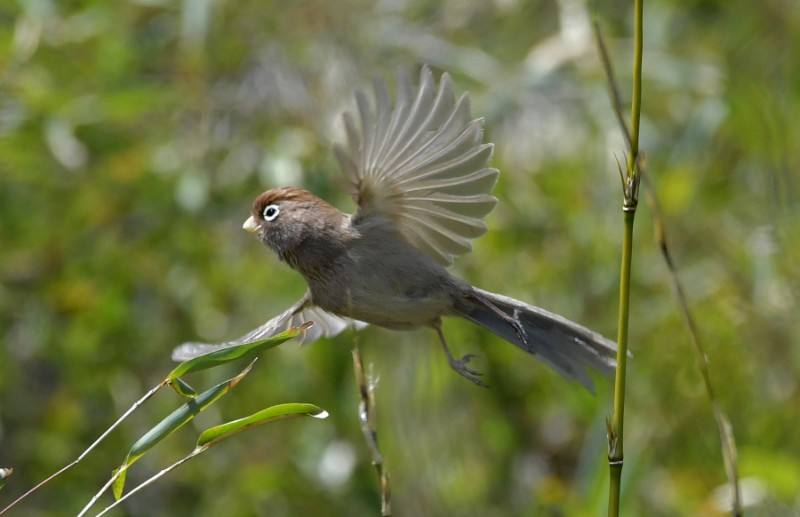Sinosuthora conspicillata
IUCN
LCBasic Information
Scientific classification
- name:Sinosuthora conspicillata
- Scientific Name:Sinosuthora conspicillata,Spectacled Parrotbill,Paradoxornis conspicillatus
- Outline:Songbird
- Family:Passeriformes Oriole Parus
Vital signs
- length:12-14cm
- Weight:8-11g
- lifetime:No verification information
Feature
The beak is yellow, short and thick, the top of the head to the back of the neck is brown with white eye circles, and the upper body is olive gray-brown
Distribution and Habitat
The White-rimmed Babbler is a bird native to China, and is only found in Qinghai (Qilian Mountains in the northeast), Gansu (Lanzhou in the west and southwest and southeast), Shaanxi (Qinling Mountains in the south), Sichuan (Pingwu, Songpan, Nanping, Wenchuan, Maoxian in the north, Wanyuan, Nanjiang in the northeast, Wuxi in the southeast, Chengdu and Baoxing in the center), and Hubei (west and southwest).
The White-rimmed Babbler mainly inhabits mountain bamboo forests and forest edge shrubs at an altitude of 1,900-2,900 meters. It also occurs in sparse grass slopes and low trees beside cultivated land. [1] It sometimes lives in reed beds or near forests and bamboo patches. Its preferred habitat is mainly between 1,000 and 3,000 meters above sea level.
Appearance
The male and female feathers are similar in color. The forehead, top of the head, pillow, nape of neck to the upper back are brown, the eye circles are white, the back, shoulders, waist and tail coverts are olive grey-brown, the wing coverts are the same as the back, the flight feathers and tail feathers are dark brown, and the outer feathers are slightly lighter. And stained with gray. The eyes, ear feathers and sides of the head are light brown. The chin, throat and upper chest are light grape red with thick dark vertical stripes, and the rest of the lower body is light brownish gray or olive brown.
The mouth is waxy yellow and the feet are dark yellowish brown.
Details
Spectacled Parrotbill, also known as Spectacled Parrotbill in English, is a small bird of the Warbler family and Parrotbill genus, with two subspecies.

The difference between the two subspecies of the White-rimmed Woodbill is that the nominate subspecies has a darker body color, a thinner bill, and a straighter beak; the Hubei subspecies has a lighter body color, a thicker bill, and a more curved beak.
White-rimmed Parrotbill is active and hides in small groups in the bamboo layer of mountain forests. It often moves alone or in pairs, and sometimes mixed with brown-headed parrotbill. It usually lives in groups of 15 or more. Sometimes, outside the nesting season, they can form groups that can accommodate 40. They forage in the middle and lower layers of trees, and even in bushes and shrubs at the foot of trees. They mainly feed on insects, and also eat fruits and seeds of plants and weeds.
White-rimmed Parrotbill generally has 4 types of sound systems. The call is a series of 4-5 fine notes, a nasal high-pitched "triiih-triiih-triiih-triiih..." and a shorter "triit" sound. It has strong penetration. There are slight variations from "ssiu" to "hsiuu" or "tsiu", they gradually rise and are repeated after intermediate intervals or longer intervals. The most notable calls are somewhat mechanical and buzzing, which can be transcribed as "trrr-trrr-trrr", alternating up and down. The alarm call is more piercing, making a "ttrrrh" or "ddrri" sound and ending with a buzzing sound.
The nesting season of the White-ringed Curlew is usually from June to August, with about 1-2 nests. The White-ringed Curlew is monogamous. The male and female share more or less equally the nesting, incubation, care and feeding of the chicks and all the main duties.
Listed in the IUCN Red List of Threatened Species (IUCN 2016 ver 3.1) - Least Concern (LC).
Listed in the Global List of Endangered Birds by Bird Life International.
Listed in the List of Terrestrial Wildlife with Beneficial or Important Economic and Scientific Research Values under State Protection issued by the State Forestry Administration of China on August 1, 2000.
Listed in the second level of the List of National Key Protected Wildlife in China.
Protect wild animals and stop eating game.
Maintaining ecological balance is everyone's responsibility!








